| Columns Retired Columns & Blogs |
Vandersteen Quatro Wood loudspeaker Measurements
Sidebar 3: Measurements
Like the plain-Jane fabric Quatro, the Quatro Wood's voltage sensitivity was well below average, at an estimated 83.5dB/2.83V/m. Its impedance, however, remains above 8 ohms at almost all frequencies, and the electrical phase angle is mild (fig.1), meaning that the speaker will be very easy to drive. The peak of 24 ohms at 60Hz suggests that this is the tuning frequency of the front-facing woofer, although, as with the Quatro, the use of an in-line high-pass filter in the amplifier feed will roll off the output above this frequency.
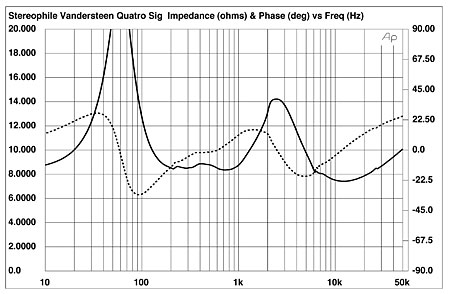
Fig.1 Vandersteen Quatro Wood, electrical impedance (solid) and phase (dashed). (2 ohms/vertical div.)
The response of this filter, set for the 100k balanced input impedance of my Audio Precision System One test system, is shown in fig.2. It's 3dB down at 60Hz rather than the expected 100Hz; I checked the internal DIP switch settings in the outboard filter, and they were correctly set for 100k ohms. I am puzzled by this design philosophy. It is very important to match the setting of this filter to the exact input impedance of your power amplifier. The amplifiers used by Wes Phillips in his auditioning had input impedances that ranged from a low of 50k ohms (Portal Paladin) through 100k ohms (Boulder 860), 200k ohms (Krell Evolution 600), to 1M ohm (Ayre MX-R). A mismatch will result in too much or too little energy in the upper bass.

Fig.2 Vandersteen Quatro Wood, frequency response of balanced high-pass filter with internal switches set for the 100k ohm input impedance of the Audio Precision System One (2dB/vertical div.).
The Quatro's powered subwoofer must have its response shaped by the inverse of this high-pass rolloff, which, all things being equal, will compromise the low-frequency noise floor by the amount of the boost. I can only assume that, as the rolloff and corresponding boost are mild, this will not be an issue. Certainly I heard no rise in low-frequency noise in my own auditioning of the Quatro and Quatro Wood. And reflecting on the design, it is indeed optimal to high-pass the upper woofer's feed at line-level than in the crossover, as the latter's filtering action modified by the interaction between the drive-unit's impedance and the series impedance of the crossover filter.
Like the fabric Quatro, the Quatro Wood's cabinet was inert in the extreme, even without the damping effect of the former's "sock." Fig.3, for example, is a cumulative spectral-decay plot calculated from the output of an accelerometer fastened to the side panel 12" from the base. While some low-level flexing can be seen at the subwoofer's tuning frequency, there is just one well-damped, low-level mode present in the subjectively important midrange. This will be benign.
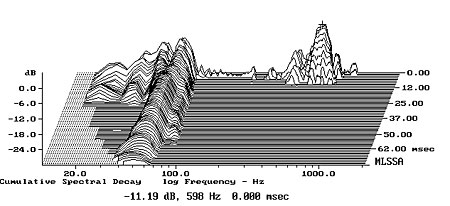
Fig.3 Vandersteen Quatro Wood, cumulative spectral-decay plot calculated from the output of an accelerometer fastened to the center of the cabinet's side panel 12" from the base (MLS driving voltage to speaker, 7.55V; measurement bandwidth, 2kHz).
As with the Quatro, the Quatro Wood is very sensitive to the listener's ear height. WP mentioned that the Vandersteen's treble sounded elevated and the presence region sucked-out when he stood up to play along with the music. Fig.4 shows the speaker's frequency response measured on axes ranging from 15 ° above the tweeter axis, itself a high 43" from the floor, to 10 ° below the woofer axis. The woofer is just 30" from the floor, but this is the axis that gives the flattest measured response for the Quatro Wood. Listen on or above the tweeter axis and you'll hear what Wes described.

Fig.4 Vandersteen Quatro Wood, vertical response family at 50", from back to front: responses 15 –5 ° above tweeter axis, response on tweeter axis, responses 5 –15 ° below axis.
The rather complicated graph in fig.5 confirms this. The blue trace on the right side of the graph is the Quatro Wood's farfield response averaged across a 30 ° horizontal window on the tweeter axis. The elevated top octaves and the poor integration between the tweeter and the midrange unit on this axis are readily apparent. The red trace is the response averaged across a 30 ° horizontal window on the woofer axis. The integration between the top three drive-units is much better, though the low treble is a little forward. The listener can fine-tune the treble balance by tilting the speaker back and forward so that his ears lie somewhere between the woofer and midrange axes.

Fig.5 Vandersteen Quatro Wood, anechoic response averaged across 30 ° horizontal window on woofer axis at 50" (red) and tweeter axis (blue), both corrected for microphone response, with the complex sum of the high-pass –filtered midrange and upper-woofer nearfield responses plotted below 300Hz; and the nearfield response of the subwoofer with the Contour control set to 7:00 (blue), 9:00 (cyan), 10:30 (green), 12:00 (black), 2:00 (red), and 4:00 (magenta).
All of these responses were taken with the speaker's grille in place, the frame of which is shaped to surround each drive-unit with a smoothly profiled surface. Remove the grille and large suckouts develop in the mid-treble, due to interference between the direct sound and the reflections from the cabinet edges.
The crossover between the midrange unit and the tweeter appears to lie at 4.6kHz, that between the midrange unit and the upper woofer around 850Hz. These responses were taken with the high-pass filter in place and set for the input impedance of the amplifier used; the red and blue traces below 400Hz are the complex sum of the midrange and upper woofer responses, measured in the nearfield. Both responses are down 3dB at 100Hz, but because the usual upper-bass bump, due to the nearfield measurement technique, is absent, it is likely that the rolloff actually starts higher in frequency.
The colored traces to the left of fig.5 show the nearfield response of the Quatro's powered subwoofer module, with the Contour control set to six settings ranging from the minimum (blue trace) to the maximum (magenta) positions. (The Quatro's 11-band equalizer was set to the control positions that Richard Vandersteen had determined to be optimal for WP's room, hence the rather lumpy appearance of these traces.) As with the fabric Quatro, the Contour control trades off low-frequency extension against the amount of midbass boost. WP had it set to the middle, 12 o'clock position for his auditioning (black trace).
The Quatro Wood's lateral dispersion was basically identical to the Quatro's, so I refer you to fig.7 in Michael Fremer's July 2006 review. As I did for MF's review, I performed a spatially averaged measurement of the Quatro Wood's response in the reviewer's room. I took 10 measurements each for the left and right speakers individually, in a grid centered on the position of WP's ears in his listening chair. I had used an AudioControl SA3050A 1/3-octave spectrum analyzer for the 2006 measurements; for this review, I used an Earthworks omni mike, a Metric Halo ULN-2 mike preamp –A/D converter, and SMUG Software's Fuzzmeasure 2.0 running on my Apple PowerBook. The results are shown in fig.6. Despite the differences in listening rooms and measurement hardware, the Quatro Woods' response in WP's room is eerily similar to that of the original Quatros in MF's room: a smooth rolloff throughout the treble, which, given the absorptive influence of room furnishings, is what I expect from a neutrally balanced design in this region; good if uneven low-frequency extension; but a gross lack of energy in the lower midrange. WP noted that male voices lacked body, and this, indeed, is what I heard when I auditioned the Quatro Woods in his system before taking the measurements.
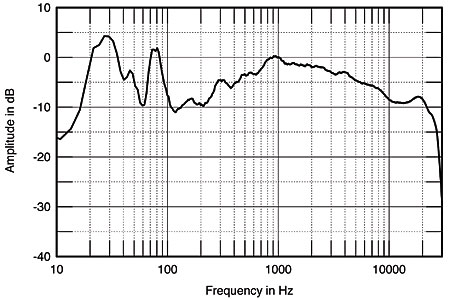
Fig.6 Vandersteen Quatro Wood, spatially averaged, 1/6-octave response in WP's listening room.
The high-pass filter's internal DIP-switch settings were correct for the input impedance of WP's Krell amplifier, which was what he was using when I visited to take the in-room measurements. All I can conjecture, therefore, is that the outputs of the midrange unit, the upper woofer, and the active subwoofer overlap to some extent in the lower midrange, and that the lack of in-room energy is due to less-than-optimal integration of their outputs in this region. To investigate this, fig.7 shows the individual step responses of these three drive-units, all taken with the high-pass filter in front of the amplifier. The midrange unit's step is shown in red, the woofer's in blue, and the subwoofer's in green. All three units are connected with positive acoustic polarity. However, the positive-going woofer step is counteracted by the negative-going overshoot of the midrange unit; in turn, the positive-going subwoofer step is counteracted by the negative-going overshoot of the woofer.
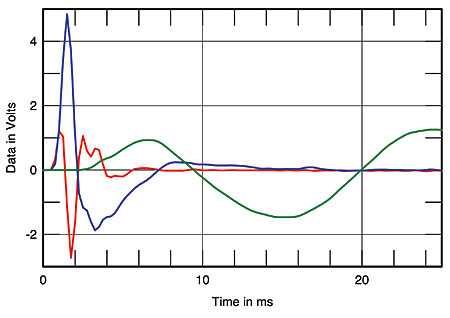
Fig.7 Vandersteen Quatro Wood, nearfield step responses of midrange unit (red), woofer (blue), and subwoofer with Contour set to 12:00 (green). (25ms time window, 1kHz bandwidth)
This is a very oversimplistic analysis, as it takes no account of the differing distances of each drive-unit from a nominal farfield listening position. But it does suggest that this lack of lower-midrange energy is inherent to the loudspeaker and not an effect of room acoustics, as I conjectured in the "Measurements" sidebar of MF's review of the Quatro.
The Quatro Wood's farfield step response on the woofer axis describes a superbly time-coincident right triangle (fig.8); this is one of the small number of loudspeakers that reproduces musical waveforms without distortion. The Quatro Wood's cumulative spectral-decay plot (fig.9) is also very clean, other than some residual modes at 2 and 7kHz, neither of which is high enough in level to degrade sound quality.
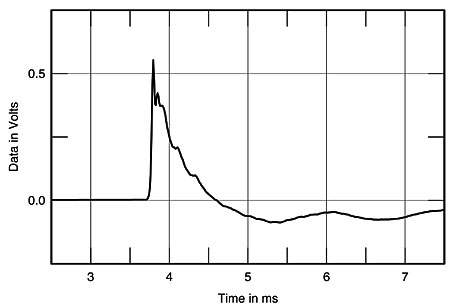
Fig.8 Vandersteen Quatro Wood, step response on woofer axis at 50" (5ms time window, 30kHz bandwidth).

Fig.9 Vandersteen Quatro Wood, cumulative spectral-decay plot on woofer axis at 50" (0.15ms risetime).
In some ways, the Quatro Wood demonstrates excellent measured performance, but in others it is quite disappointing. It should also be remembered that measuring a speaker as complicated as this is in some ways an exercise in frustration. Wes very much liked what the Quatro Wood did in his system, so I will let him have the final word. —John Atkinson
- Log in or register to post comments




































